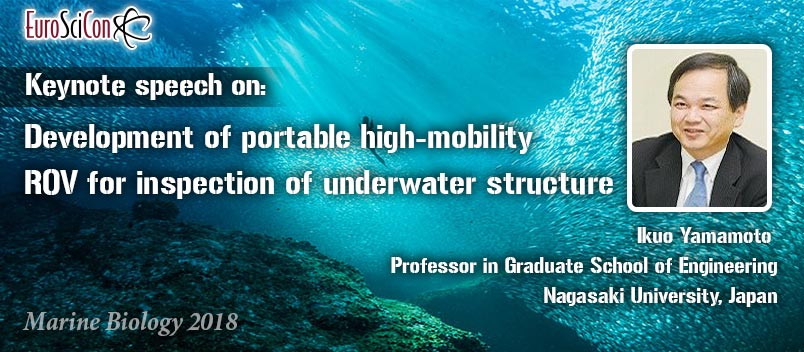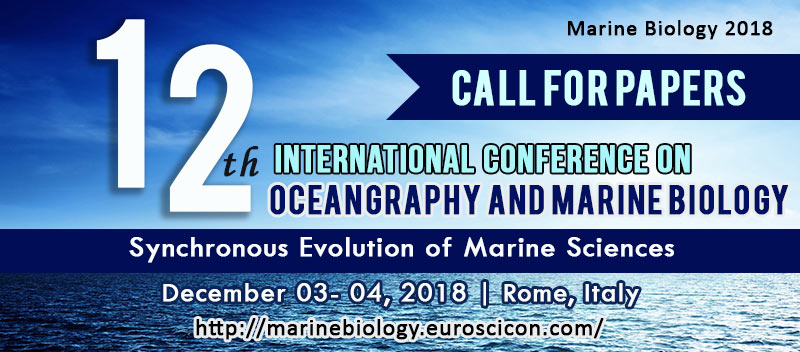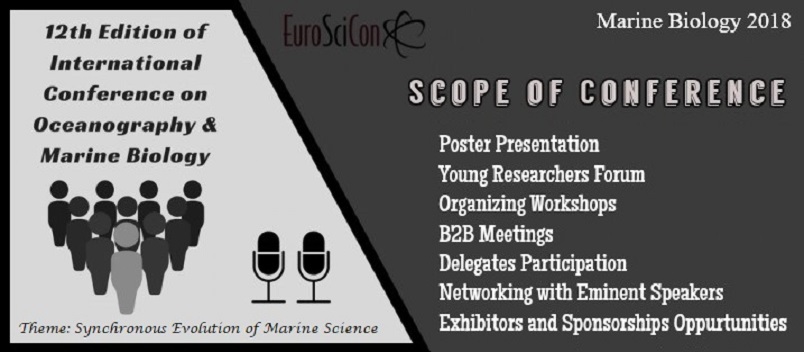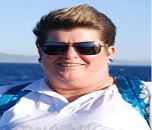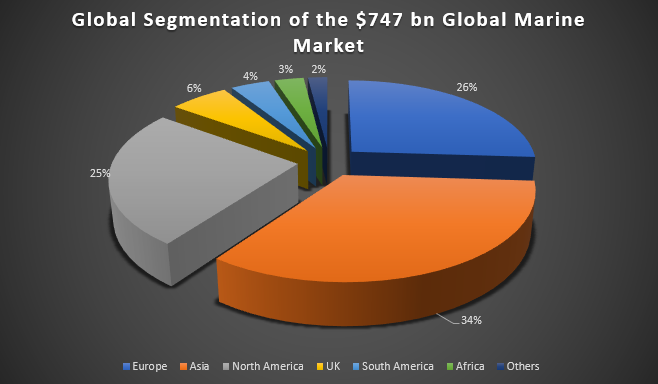Oceanography 2018
About Conference
Euroscicon Ltd offers all the participants from all over the Globe to attend “12th International Conference on Oceanography & Marine Biology” during December 3-4, 2018 at Rome, Italy. It includes prompt Keynote presentations, Oral presentations (Speaker forum and Young research forum), Poster presentations, and Exhibitions. This is going to be one of the most notable events of the year. It will bring all the Scientists, Professors and Delegates together for a remarkable success.
The Theme of the Conference is "Synchronous Evolution of Marine Sciences". The main objective is to bring all the leading academic scientists, researchers and research scholars together to exchange and share their experiences and research results about all the aspects of Marine Science. It also provides the premier interdisciplinary forum for researchers, practitioners and educators to present and discuss the most recent innovations, trends, and concerns, practical challenges encountered and the solutions adopted in the field of Oceanography. The conference program will cover a wide variety of topics relevant to the Marine Science, including: Physical significance of Oceanography, Marine Geology, various technology in marine science, Marine Pollution, Marine Biology and so on.
Importance & Scope of Oceanography:
Oceanography overspread both the deep oceans and the much shallower coastal regions. The wideness of understanding in oceanography means oceanographers tends to be rather specialized around one specific subject. Diverse types of tools and instruments are used in oceanography. While ships are also a part of this, other methods, such as stationary underwater observations, are also used to study the ocean. Modern oceanographers also use automated underwater transport and advanced scanning devices to exhibit information faster than a direct human effort could accomplish.
The Conference will provide an overview on the latest trends and achievements in ocean sciences and technologies applied to oceanography and will explore future needs, developments as well as management and governance. The target audience is intended initially for oceanographers, engineers, researchers, academics, industry leaders, conservation organizations, policy and decision makers that have coastal and marine associated responsibilities.
Marine Biology is the Scientific Study of the animals inside the ocean. Given that in science numerous phyla, families and genera have a few animal varieties that lives in the ocean and others that lives ashore, sea life science orders species in light of the earth instead of on scientific categorization.
The complete world is concentrated on learning about Marine Science and its benefits, so this is the best opportunity to reach largest assembly of participants from the Marine Science community. Distribute information, conduct presentation, and meet with current and potential scientists. Make a splash with new researches and its developments in this 2-days event at “12th International Conference on Oceanography & Marine Biology”. World-renowned speakers, recent techniques, developments and newest updates in Marine Science are the compact of this conference. Hence, you all are welcomed to be a part of this conference to contribute your research ideas.
Scientific Sessions
Marine Biology 2018 – Scientific Sessions
Session 1: Oceanography
Oceanography is the investigation of the physical and the organic parts of the sea. It is an Earth Science which covers an extensive variety of points, including biological community flow, sea streams, waves, and geophysical Fluid Dynamics, plate tectonics and the geography of the ocean depths; and transitions of different compound substances and physical properties inside the sea and over its limits. These various points mirror numerous controls that oceanographers mix to promote information of the world sea and comprehension of procedures inside topography, hydrology, meteorology, material science, astronomy, biology, chemistry, geography, geology and physics.
Session Keywords:
- Oceanography Conferences
- Marine Biology Conferences
- Marine Ecology Conferences
- Marine Sciences Conferences
- Oceanographers Conferences
- Ocean Science Conferences
- Ocean Science Meetings
- Aqua Science Meetings

Session 2: Marine Biology
The sea majorly affects the biosphere. Life inside the sea developed around 3 billion years preceding life ashore. Both the profundity and the separation from shore unequivocally impacted the biodiversity of the plants and creatures display in every locale. The sea life science major is intended for the presentation of marine biological systems, including the colossal decent variety of marine life forms and their waterfront and additionally maritime conditions.
- Marine Biologists
- Marine Biology Conferences 2018
- Marine Biology Conferences
- Marine Biodiversity
- Marine Biology researchers
- Oceanographers Meetings 2018
- Marine Biology
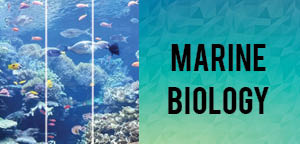
Session 3: Physical Oceanography
Physical oceanography is the study of the physics and topography of the sea streams and water properties and investigating it. It has a key application in intercontinental climate and beach front examinations. It is likewise a key segment in the interdisciplinary investigations of initial creation, maritime transition, aqueous vents and capacity of carbon dioxide. Physical oceanography takes enthusiasm on plotting and understanding the advancing examples of sea development and the smooth movements, going with the conveyance of its properties, for example, temperature, fixation and the saltiness of broke down synthetic components and gasses.
- Session Keywords:
- Oceanography Conferences
- 52nd European Marine Biology Symposium
- World Congress On Marine Science
- Oceanography Meetings
- Biological Oceanography Conferences
- Ocean Meetings

Session 4: Marine Geology
Marine Geology is the research of the history and structure of the sea depths, it is additionally called as topographical oceanography. It includes geochemical, geophysical, paleontological and sedimentological examinations of the beach front zone and also sea depths. Marine geology has a solid attach to physical oceanography. Marine Geology centers the examinations in zones influenced by The Oceans. These are the profound sea floor, the shallower slant and banks that edge the mainland’s, and particularly the coasts which incorporate shorelines, estuaries, waterways, and huge lakes.
Session Keywords:
- Oceanic Engineering Society
- OCEANS 2018
- World Congress on Marine Science
- Oceanography summit
- Marine Geology Sciences
- Marine Science Events
- Marine Biology
- Aqua Science Meetings
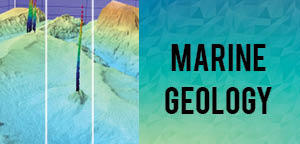
Session 5: Marine Technology
Marine Technology manages the development, operation and support of watercrafts. A portion of the advances associated with marine innovation are marine building, maritime engineering, transport building, deliver plan, and ship operations, oil and gas investigation, exploitation, creation, navigation, submerged innovation, hydrodynamics, ocean surface and sub-surface help, marine assets (both sustainable and non-inexhaustible marine assets)
Session Keywords:
- Oceanic Engineering Society
- OCEANS 2018
- Satellite Oceanography Conferences
- Oceanography summit
- Marine Geology Sciences
- Marine Technology Summit
- Marine Technology Conferences
- Ocean Science Events
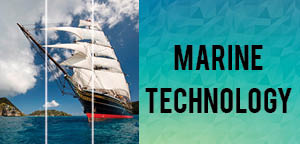
Session 6: Marine Ecology
Marine Ecology is the scientific investigation of the marine-life domain, population, and associations among the animals and the surroundings including their abiotic and biotic components. Marine biological communities are among the greatest of Earth's oceanic environments. A portion of the illustrations are salt bogs, intertidal zones, estuaries, tidal ponds, mangroves, coral reefs, the remote ocean, and the ocean depths.
Session Keywords:
- Oceanography Conference
- Marine Biologist
- Marine Biologist
- Aquatic Conference
- Geoscience Conference
- International Geoscience
- European Geophysical Society
- Geological Survey of Canada
- Aqua Science Meetings
- Ocean Conference

Session 7: Marine Chemistry
Marine Chemistry principally states about the chemical synthesis and compound procedures of the Global Ocean. Marine chemistry is a part of hydrosphere, it additionally portrays about the biochemistry, geochemistry, ecological science and atmospheric chemistry. It manages the connection and conditions between the natural and inorganic exacerbates, the organic, physical and topographical conditions in the ocean. Sea science are influenced by pH levels, Marine Transportation, Environmental Hazards, Silt and Biology.
Session Keywords:
- Oceanography Conference
- Marine Biologist
- Marine Biology Conferences
- Marine Life Conference
- World Congress on Marine Science
- Biochemistry Conference
- Chemical Oceanography Conferences
- Ocean Conferences
- Aqua Science Meetings
- Ocean Science Meetings

Session 8: Ocean Biogeochemistry
Biogeochemistry is another scientific discipline in which the physical, chemical, organic, and topographical procedures are investigated. Biogeochemistry examines the cycles of basic components, for example, carbon and nitrogen, and their cooperation’s with different life forms and substances as they travel through Earth's air, biosphere (life), hydrosphere (water and ice), and lithosphere (rocks). Accentuation is set on the investigation of carbon, nitrogen, sulfur, and phosphorus cycles. Biogeochemistry is a frameworks science firmly identified with frameworks of biology.
Session Keywords:
- Oceanic Biochemistry Conferences
- Marine Sciences Conference
- Atmospheric Oceanography
- Biogeochemical Oceanography
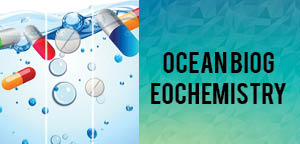
Session 9: Coastal Oceanography
Coastal oceanography grasps the investigation of the physics, chemistry, ecology, and geology of the "coastal ocean." The beach front sea connects the mainland’s and the open (profound) sea; in that capacity, it overlies the mainland edge that comprises of the shallow mainland rack, soak mainland slant, and the profound mainland rise. These solid varieties in water profundity, and related geomorphological irregularities (for instance, submarine gorge and capes and submarine banks and bowls), together with earth turn, apply controls on the heading of beach front sea dissemination. Thickness stratification, erosion, and transition intercede these imperatives
Session Keywords:
- Oceanography Conference
- Marine Sciences Conference
- Coastal Oceanography Conference
- Coastal Oceanography
- Coastal Research and Education Society of Long Island
- Korea Society of Coastal and Ocean Engineers
- Oceanography Meetings
- Marine Biology Meetings
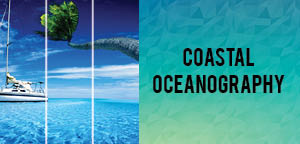
Session 10: Marine Pollution
Marine pollution can be described as anything that impure the sea. Common Marine Pollutants include chemicals, small plastic beads in exfoliants and toxic bio-matter. But due to the noise, excessive traffic occurs around the ocean by which it can also be defined as pollution if it disrupts marine life. Marine pollution occurs when harmful, or potentially harmful, effects results from the entry into the ocean of chemicals, industrial, residential waste and agricultural noise or the spread of fast growing organisms.
Session Keywords:
- Oceanography Meetings
- Marine Biology Conference
- Aqua Science Meetings
- Eco-toxicology Conference
- Marine Pollution facts
- Industrial Toxicology Conference
- Marine Geochemistry Conference
- Oceanographers
- Marine Biology

Session 11: Ocean and Climate
Sea Covers 70 percent of the Earth's surface, the world's seas have a two-route association with climate and atmosphere. The Oceans impact the climate on neighborhood to worldwide scales, while changes in atmosphere can on a very basic level adjust numerous properties of The Oceans. This theme looks at how some of these key attributes of The Oceans have changed after some time. Understanding the impact of sea conditions on the Earth's atmosphere and observing changes in sea conditions are vital to anticipating environmental change.
Session Keywords:
- Oceanic Conferences
- Marine Biologists
- Atmospheric Oceanology Conferences
- European Geophysical Society
- International Hydrographic Organization
- World Congress on Marine Sciences
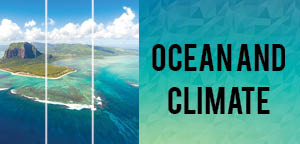
Session 12: Oceanographic Instrumentation
Oceanographic Instruments are used to estimate diverse types of physical, chemical and biological quantities in the water column. There is not just a single way to measure a quantity, there are many quantities to be measured hence, there are several instruments. This track will endeavor to overspread more common instruments used by an oceanographer.
Session Keywords:
- Ocean Conferences
- Oceanic Instrumentation
- Oceanic instrumentation and Technology
- Aquatic Science Conferences
- Canadian Meteorological and Oceanographic Society
- World Meteorological Organization
- Oceanographic Biology Conference

Session 13: Oceanography Market
Oceanography overspread both the deep oceans and the much shallower coastal regions. The wideness of understanding the oceanography means Oceanographers tends to be rather specialized around one specific subject. Several types of tools and instruments are used in oceanography. While ships are also a part of this. Other methods such as stationary underwater observations are also used to study the Ocean. Modern Oceanographers also use automated underwater transport and advanced scanning devices to exhibit information faster than a direct human effort could accomplish.
Session Keywords:
- Marine Biology Conference
- The Ocean Conference
- Ocean Business
- United Nation Ocean Conferences
- Marine Biologists
- Ocean Conservation Society
- The Global Market
- Aqua Science Meetings
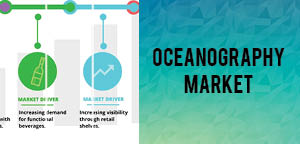
Session 14: Clathrate hydrate
Clathrates have been found to happen ordinarily in significant sums. Around 6.2 trillion tons of methane is gotten in stores of methane clathrate on the deep ocean depths. Such stores can be found on the Norwegian terrain resign in the northern headwall flank of the Storage Slide. Clathrates can in like manner exist as permafrost, as at the Mallik gas hydrate site in the Mackenzie Delta of northwestern Canadian Arctic. These combustible gas hydrates are seen as a conceivably colossal imperativeness resource; however, a calm extraction methodology has so far exhibited unpretentious.
The closeness of clathrates at a given site can frequently be controlled by impression of a "base mirroring reflector" (BSR), which is a seismic reflection at the buildup to clathrate strength zone interface caused by the unequal densities of run of the mill residue and those bound with clathrates. Gas hydrate pingos, have been found in the Arctic oceans Barents Sea. Methane is ascending from these vaults like structures, with some of these gas flares extending close to the sea surface.
Session Keywords:
- Oceanography Conference
- Marine Biologists
- Aquatic Conference
- Geoscience Conference
- International Geoscience
- European Geophysical Society
- Biological Systems
- Aquatic Science Conferences
- Oceanographers Meet
- Marine Biology

Session 15: Organisms of the Open Sea
Numerous species that live in the vast sea or sea universe. Over 70% of the Earth's surface is occupied by sea and recollect that over half of the Earth's surface is secured by sea that is no less than two miles profound. Many untamed sea living beings experience their reality while never meeting the shore, the ocean bottom, or the water's surface. They spend their whole lives encompassed by water on all sides and don't have the foggiest idea about that whatever else even exists. Because of profound open seas, living beings never at any point see daylight.
Session Keywords:
- Oceanography Conference
- Marine Geology Conference
- Aquatic Science Meetings
- Ecological Oceanography
- Oceans Meeting
- Ocean Conference
- Oceanic Organisms
- Marine Biology Conference
- Marine Science Meetings

Session 16: Function and Environment
Billions of Marine Microorganisms are present in each litter of seawater which represents an organized environmental group that controls how the Earth capacities in essentially every path, from vitality utilization to breath. As they are the tenants of the biggest condition on Earth, Microbial marine frameworks drive is changing in each worldwide framework.
Session Keywords:
- Oceanic Marine Biology Conference
- Aquatic Science Conferences
- Environmental Biochemistry Conference
- Oceanography Conference
- Microbial Marine System
- Environmental Oceanography Conference
- Aqua Science Meetings

Session 17: Coral Reefs
Reefs comprise a portion of the densest and most differing territories on the planet. The best-known sorts of reefs are tropical coral reefs which occupy in most tropical waters; be that as it may, reefs can likewise exist in cool water. Reefs are developed by corals and other calcium-settling creatures, as a rule over a rough outcrop on the sea floor. Reefs can likewise develop on various surfaces, which has made it conceivable to make manufactured reefs. Coral reefs likewise bear a gigantic area of life, including the corals themselves, their cooperative zooxanthellae, tropical fish and numerous different life forms.
Session Keywords:
- Marine Biology Conference
- Oceanic Conference
- Aquatic Science Conferences
- The Oceans
- Marine Ecologists
- Coral Reefs Symposium
- The Society for Underwater Technology
- British Marine Life Study Society
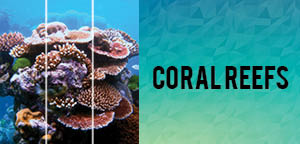
Session 18: Reproduction, Dispersal, and Migration
A standout amongst the most fundamental qualities of living things is the capacity to reproduce—to create posterity like themselves. Any life shape that neglected to supplant itself with new people of its own kind would soon vanish from the planet. It is just by recreating that an animal types guarantees its own particular survival. Life forms must do two things when they replicate. To begin with, they should deliver new people to sustain the species. Second, they should pass on to this new age the attributes of the species as hereditary data.
Session Keywords:
- Oceanography Conference
- Marine Biologist
- Marine Biologist
- Aquatic Conference
- International Marine Science
- European Biological Society
- The Oceans
- Oceanographers
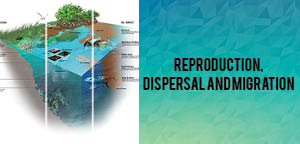
Session 19: Life Near the Surface
The ocean, for most of us, conjures up images of beaches and cliffs, breaking surf, or quiet bays. Such familiar nearshore waters, however, make up only a small fraction of the world ocean. The rest is the vast open sea, the pelagic realm. Though distant and unfamiliar, the open ocean affects us all. It regulates our climate, conditions our atmosphere, and provides food and other resources. The rest is the vast open sea, the pelagic realm.
Session Keywords:
- Oceanic Engineering Society
- OCEANS 2018
- Aquatic Science Meetings
- World Congress on Marine Science
- Oceanography summit
- European Marine Observation
- Marine Geology Sciences
- The Oceans
- Geological Survey of Canada

Session 20: Coastal Benthic Environments
The Benthic Zone is where the natural division are at the most reduced piece of a group of sea or a lake, including the deposit surface and some sub surface layers. Living beings living in this zone are depicted as benthos, for instance the benthic invertebrate group, including polychaetes and the scavengers. The creatures normally live closely with the preparatory base and many are for all time appended to the base.
Session Keywords:
- Oceanography Conference
- Marine Sciences Conference
- Coastal Oceanography Conference
- Coastal Research and Education Society of Long Island,
- Oceanography Meetings
- Benthic Ecology Meetings
- Benthics 2018
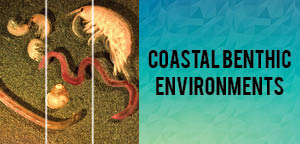
Session 21: Human Impact on the Sea
People massively affect the sea. In fact, proof of people can likewise be discovered everywhere throughout the Oceans, even in the most remote polar territories, through gliding refuse. Contamination isn't the main or fundamentally most essential way we influence the marine condition. This segment quickly outlines issues caused by human exercises like, dumping, digging of residue or mud, landfilling, or even of the utilization of explosives.
Session Keywords:
- Ocean Conference
- Oceanic Technology
- Oceanographic Society
- Oceana
- Oceanographic Biology Conference
- Conference Sea and Society
- Marine Sciences Conference
- The Oceans
- Aquatic Science Meetings
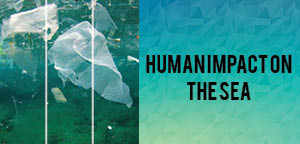
Session 22: Aquaculture
Aquaculture implies cultivating of oceanic living beings including fish, mollusks, and amphibian plants. It alludes to breading, raising and gathering in a wide range of water situations. Fisheries allude to demonstration of refined, safeguarding, showcasing, creating and dealing with the amphibian asset. The principle impact of aquaculture on water quality is to expand the suspended substances and the wholesome salts in water.
In Europe, aquaculture represents around 20% of fish creation and specifically utilizes somewhere in the range of 85 000 individuals. The part is fundamentally made from SMEs or small-scale ventures in beach front and country regions. EU aquaculture is eminent for its top notch, supportability and customer assurance measures.
Session Keywords:
- Oceanography Conferences
- Marine Biology Conferences
- Marine Ecology Conferences
- Marine Sciences Conferences
- Oceanographers Conferences
- Ocean Science Meetings
- Conferences 2018
- Aqua Science Meetings
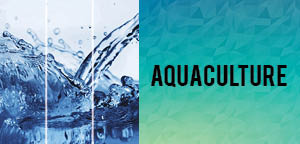
Session 23: Deepsea Discoveries
The deep-Sea floor speaks to the biggest living space on earth. It ranges from the edge of the mainland rack at 200m to the base of the sea. At the edge of the mainland rack is the rack break, where the angle of the floor increments down the mainland slant. Underneath the mainland slant lies the mainland rise, which has a more delicately slant. At around 4,000 meters profundity, the sea floor is come to and stretches out finished the sea bowls at profundities of 5,000 meters by and large. This is known as the “abyssal plain’’. The zone between the mainland rack and the deep plain is the bathyal zone. In a few places, the ocean depths drop again into prolonged trenches with profundities of 10 to 11 kilometers. This district is the hadal locale. The sea floor is hindered by mountain chain known as the mid-maritime edge framework. Different highlights on the sea depths are seamounts and aqueous vents.
Session Keywords:
- Oceanography Conferences
- Marine Biology Conferences
- Marine Ecology Conferences
- Marine Sciences Conferences
- Oceanographers Conferences
- Ocean Science Conferences
- Ocean Science Meetings
- Conferences 2018
- Aqua Science Meetings
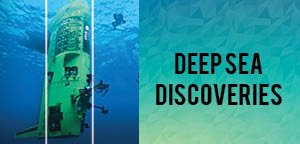
Session 24: Marine Genomics
Genetic investigations have much to offer marine supervisors, particularly in the arrangement of devices empowering unequivocal example recognizable proof and evaluation of stock structure. Biotechnology gives ground-breaking devices to the supportable advancement of marine, aquaculture, fisheries, and the food business. The development of overall marine has been maintained and fast, and the blast of research in genetic biotechnology has had huge effect on Marine Biology.
Session Keywords:
- Oceanography Conference
- Marine Biologist
- Marine Biology Conference
- Marine Life Conference
- World Congress on Marine Science
- Biochemistry Conference
- Chemical Oceanography Conference
- Ocean Conferences
- Aqua Science Meetings
- Ocean Science Meetings

Session 25: Fisheries Science
Fishery is the sort of industry which incorporates getting and offering of fishes for nourishment, pharmaceutical and research. Other than marine water fisheries there are fresh water fisheries too. There are two sorts of waters the fresh and the brackish. The fresh water sources are water system waterways, repositories, lakes, tanks, lakes. The estuaries, tidal ponds and mangrove swamps constitute the brackish sort of water.
Session Keywords:
- Oceanography Conference
- Marine Sciences Conference
- Coastal Oceanography Conference
- Coastal Oceanography
- Coastal Research and Education Society of Long Island
- Korea Society of Coastal and Ocean Engineers
- Oceanography Meetings
- Marine Biology Meetings
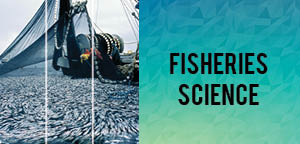
Session 26: Microplastics
Plastic is the most predominant kind of marine refuse found in our ocean and Great Lakes. Plastic refuse can come in all shapes and sizes, however those that are under five millimeters are called "microplastics."
Microplastics can originate from an assortment of sources including bigger plastic pieces that have broken separated, sap pellets utilized for plastic assembling, or as microbeads, which are little, fabricated plastic dots utilized as a part of wellbeing and excellence items, for example, a few chemicals and toothpastes. These little particles effortlessly go through water filtration frameworks and wind up in the sea and Great Lakes, representing a potential risk to oceanic life.
Session Keywords:
- Oceanography Meetings
- Marine Biology Conference
- Aqua Science Meetings
- Eco-toxicology Conference
- Marine Pollution facts
- Industrial Toxicology Conference
- Marine Geochemistry Conference
- Oceanographers
- Marine Biology
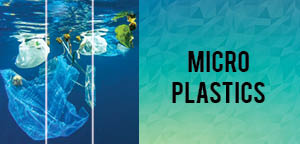
Market Analysis
It is accepted that over 90% of world exchange is passed on via ocean and over the period 1985 to 1999, world seaborne exchange increased by half to around 5 billion tons with the biggest development coming in unrefined petroleum and different oil items relegations. Amid 1990-98 development collected 3.2% for each annum. From that point forward a portion of the nations concerned have finished a turnaround. Worldwide markets comprise of three noteworthy locales; Europe and North America are comparable in measure shaping 25% and 26% of the market.
- Oceanography Asia
- Oceanography Europe
- Oceanography Middle East
- Oceanography USA
The Global Market
The greater part of the business sectors we talk about commonly incorporates three components: the affirmation gear, the cost of operations, and the yield esteem. To put it plainly, the subject is complex. This entanglement is additionally expanded by the way that segments cover and one may supply to another for instance the shipbuilding business supplies vessels to the seaward oil industry. In any case, the summation of the things that are use, gives an estimation of $747 billion and empowers us to infer a perspective of the worldwide division of the marine businesses.
- Marine Transportation,
- The Leisure Industries Including Leisure Boating and The Cruise Business,
- Marine Biotechnology,
- Seaward Oil and Gas Industry,
- Marine Services in Its Many Aspects,
- Minerals (Specifically Offshore Diamonds),
- The Ports Industries,
- Submerged Vehicles,
- Submarine Cables,
- Marine IT (But from A Small Base)
- Sustainable power source (From an Even Smaller Base)
Marine Biology
Sea life Biology distributes unique and all inclusive outstanding commitments from each field of sea life science. Uncommon significance is given to the articles which advances the comprehension of life in the ocean, life form and condition collaborations, cooperations amongst living beings, and the working of the marine biosphere.
Aspects of interest include:
- Marine Biogeochemistry
- Ecology of Marine Populations and Communities
- Marine Ecophysiology
- Behavioural Biology of Marine Organisms
- Development and Life Cycles of Marine Organisms
- Biochemistry and Physiology of Marine Organisms
- Evolution of Marine Organisms
- Population Genetics of Marine Organisms
- Marine Conservation
- Technology Developments in Marine Biology
Some specific areas of research include:
- Using automated DNA analysis for studying Marine Algae and microbes
- Iron and algal blooms
- How marine algae interact with other marine organisms, ocean chemistry, and climate
- The ecology and genetics of microscopic marine algae
- Red tides and algal blooms
- Marine microbes (bacteria and archaea)
Research objectives in marine biology aim to implement functional and environmental genomic approaches to increase knowledge on certain marine model organisms, and better understand the functioning and biodiversity of marine ecosystems in a context of global change.
Benefits from a Social Economic Perspective
Significant beneficial position would result to genetic enhancement of food fish. Included among these benefits are the potential for reduced pressure on natural fisheries and perhaps preserving some of the biodiversity of the marine environment. This later benefit is certainly dependant on the future regulation and reaction of the world's fishing fleets, as previously noted. This is a particularly significant benefit because seafood demand is expected to increase 70% in upcoming 35 years (JSA 1992; NSTC 1995), and in six of 11 fishing zones, more than 60% of species have already been depleted or fished to their biological limit (FAO 1995). This fact has additional economic implications for labour markets.
Learn More
Top Oceanography and Marine Biology Universities Worldwide:
Marine Biology Universities in Europe:
Alfred Wegener Institute for Polar and Marine Research | Marine Biology Conferences | GEOMAR Helmholtz Centre for Ocean Research Kiel | Centre for Tropical Marine Ecology | Oceanography Conferences | Institute for Chemistry and Biology of the Marine Environment | Italian National Research Council | Centre d' Oceanologie de Marseille | Station biologique de Roscoff | Aquaculture Conferences | Observatoire Oceanologique de Villefranche | LOCEAN, Paris | Institute of Oceanology of Polish Academy of Science | Institute of Oceanography of University of GdaÅ„sk | Marine Biology Conferences | Maritime Institute in GdaÅ„sk | Marine Biological Association, Plymouth | University of East Anglia |Marine Biology Conferences | National Oceanography Centre, Southampton | Marine Biology Conferences | Gatty Marine Laboratory, St Andrews, Scotland | British Oceanographic Data Centre, Liverpool | Institute of Marine Sciences | Oceanography Conferences | Hellenic Centre for Marine Research (HCMR) | Marine Biology Conferences |Royal Netherlands Institute for Sea Research | University of Groningen - Master's degree programmes | INPOH, Instituto Nacional de Pesquisas Oceanográficas e Hidroviárias | Marine Biology Conferences |(National Institute for Oceanographic and Waterway Research) | Fundação Universidade Federal do Rio Grande, FURG | Aquaculture Conferences | Stockholm Marine Research Centre | Marine Biology Conferences | University of Gothenburg | Institute of Oceanography and Fisheries | Institute for marine and coastal research, University of Dubrovnik | Oceanography Conferences | Institute of Marine Research | Institute of Oceanology - Bulgarian Academy of Sciences, Varna | Oceanography Conferences | University of Alaska Fairbanks | University of California-Davis | University of California-Santa Barbara | University of California-Santa Cruz | Marine Biology Conferences | University of California-San Diego | University of Connecticut|
Marine Biology Universities in USA:
Massachusetts Institute of Technology | National Oceanic and Atmospheric Administration | American Geophysical Union | Marine Biology Conferences | American Society of Limnology and Oceanography | Bigelow Laboratory for Ocean Sciences (Maine) | Oceanography Conferences | Florida Institute of Technology | Harbor Branch Oceanographic Institution HBOI | Hawaii Pacific University | Humboldt State University (California) | Florida State University | Georgia Institute of Technology | Aquaculture Conferences | Lamont–Doherty Earth Observatory | Louisiana State University | Marine Biological Laboratory (MBL) | Monterey Bay Aquarium Research Institute (MBARI) | Moss Landing Marine Laboratories | Marine Biology Conferences | NASA Goddard Space Flight Center | National Oceanic and Atmospheric Administration (NOAA) | Naval Oceanographic Office | Naval Postgraduate School | Oceanography Conferences | Northeastern University Marine Science Center | Oregon State University | Princeton University | Rosenstiel School of Marine and Atmospheric Science, University of Miami | Aquaculture Conferences | Rutgers University (New Brunswick) | Schmidt Ocean Institute | Texas A&M University | University of California-Santa Barbara | University of California-Santa Cruz | University of California-San Diego | University of Connecticut | Marine Biology Conferences | University of Colorado (Boulder) | University of Delaware, College of Earth, Ocean and Environment | Nutrition Conferences | Plant Science Conferences
Marine Biology Universities in Asia:
Ocean University of China | Swire Institute of Marine Science | Chinese Academy of Sciences | The Second Institute of Oceanography | Marine Biology Conferences | State Oceanic Administration | State Key Laboratory of Satellite Ocean Environment Dynamics | Centre of Advanced Study in Marine Biology & Oceanography (CASMB) | Oceanography Conferences | Indian Institute of Technology Delhi | Indian Institute of Technology Kharagpur | Indian Institute of Science | Center for Earth and Space Sciences | Aquaculture Conferences | Centre for Ocean and Coastal Studies | Centre for Atmospheric and Ocean Studies | Centre for Marine Living Resources and Ecology, Ministry of Earth Sciences | Centre for Marine Science and Technology | Marine Biology Conferences | Central Marine Fisheries Research Institute, Kochi | Central Institute of Fisheries Technology | Nutrition Conferences | Plant Science Conferences | Department of Meteorology and Oceanography | Goa University | Oceanography Conferences | Karnatak University | Research Center For Oceanography LIPI Jakarta | Bogor Agricultural University. Marine Science and Technology Department | Aquaculture Conferences | Bandung Institute of Technology | Diponegoro University | Marine Science Faculty in Tarbiat Modares University | Iranian National Institute for Oceanography and Atmospheric Science | Marine Biology Conferences | Khorramshahr marine science and technology university | Islamic azad university of Tehran | Japan Agency for Marine-Earth Science and Technology | Oceanography Conferences | Tokyo University of Marine Science and Technology | Kobe University | University of the Ryukyus | Center for Maritime History | National Sun Yat-Sen University | Aquaculture Conferences | National Dong Hwa University | National Taiwan Normal University | National Taiwan University | National Taiwan Ocean University |
American Society of Limnology and Oceanography (ASLO) | Marine Biology Conferences | ANalyse Educatie en Marien Oecologisch ONderzoek (ANEMOON) | Australian Marine Sciences Association | Australian Meteorological and Oceanographic Society | Oceanography Conferences | British Geological Survey (BGS) | British Marine Life Study Society | Canadian Meteorological and Oceanographic Society | CIESM - The Mediterranean Science Commission | Aquaculture Conferences | Coastal Research and Education Society of Long Island (CRESLI) | European Federation of Marine Science and Technology Societies (EFMS) | European Geophysical Society | Marine Biology Conferences | European Marine Observation and Data Network (EMODnet) | European Science Foundation Marine Board | Florida Oceanographic Society | Geological Survey of Canada | Oceanography Conferences | Hebridean Whale and Dolphin Trust | Institute of Marine Engineering, Science and Technology (IMarEST) | Inter-Agency Committee on Marine Science and Technology | Intergovernmental Oceanographic Commission (IOC) | Aquaculture Conferences | Intergovernmental Oceanographic Commission of UNESCO (IOC) | International Association of Aquatic and Marine Science Libraries and Information Centers (IAMSLIC) | Marine Biology Conferences | International Federation of Hydrographic Societies | International Hydrographic Organization (IHO) | International Maritime Organisation (IMO) | Italian Association of Oceanography and Limnology | Oceanography Conferences | Joint Oceanographic Institutions (JOI) | Korea Society of Coastal and Ocean Engineers | Marinalg International | Marine and Oceanographic Technology Network | Aquaculture Conferences | Marine Conservation Society | Nutrition Conferences | Plant Science Conferences | Marine Environmental Research Institute | Marine Technology Society | National Association of Marine Laboratories | Marine Biology Conferences | National Shellfisheries Association | New Zealand Region of the Hydrographic Society | Ocean Conservation Society | Ocean Society of India | Oceanography Conferences | Oceanic Society | Oceanographic Society of Japan (JOS) | The Association of Marine Laboratories of the Caribbean | The Hydrographic Society | Aquaculture Conferences | The Hydrographic Society of America | The Oceanography Society | The Society for Marine Mammalogy | The Society for Underwater Technology (SUT) | Marine Biology Conferences | Union des Oceanographes de France | Western Indian Ocean Marine Science Association (WIOMSA) | Whale and Dolphin Conservation Society | Oceanography Conferences | World Meteorological Organisation (WMO) | Western Indian Ocean Marine Science

